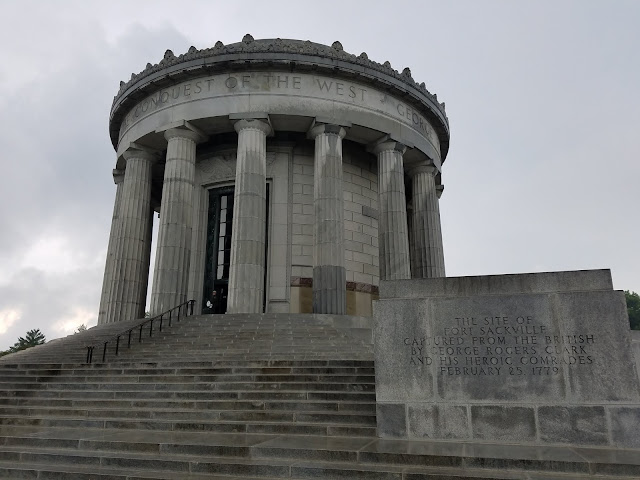Hello
and welcome back to our blog. In this
post we travel to Indiana to visit the memorial to the man whose exploits
secured the northwest for the United States and opened the west to expansion.
 |
| Entrance sign. |
BACKGROUND:
In
1778, as the American War of Independence dragged on, the governor of Virginia,
Patrick Henry, approved an expedition to secure American claims to the
territory between the Appalachian Mountains and the Mississippi river. To command this expedition, Virginian George
Rogers Clark was appointed to lead men down the Ohio river and capture several
British forts in the Illinois wilderness.
Despite having a far smaller army than promised, Clark seized the
British posts with complete surprise and managed to broker peace with several
Indian tribes. During the winter the
British struck back, the British governor of the Northwest Territories, Henry
Hamilton, personally leading a force from Detroit which recaptured Fort
Sackville on the eastern bank of the Wabash river.
Clark,
realizing that a British resurgence might erase all of the Americans' gains, gathered up his
small force and marched back across Illinois from St. Louis in the dead of
winter. As they approached their
objective, Clark and his men came across the Wabash river, swollen from winter
snows and rains which had turned the entire area around Fort Sackville into an
icy swamp. Undaunted, Clark lead his men
onward, wading through miles of freezing cold water. Finally, after completing the arduous march,
Clark’s troops assaulted Fort Sackville.
Thinking that he was facing a far superior force, the Governor Hamilton
surrendered to Clark on February 25th, 1779. The capture of the British posts throughout
the frontier allowed the United States to go into peace negotiations with a
much stronger bargaining position, allowing the new nation to firmly claim the
Northwest Territory, the modern states of Ohio, Indiana, Michigan, Illinois,
and Wisconsin.
As
for George Rogers Clark himself, despite his heroics in helping win the west,
he was soon eclipsed in fame by his younger brother William Clark, who along with
Meriwether Lewis led the Corps of Discovery on their famous journey across
the west to the Pacific Ocean. To memorialize
this overlooked hero, the state of Indiana with assistance from the Federal
government, commissioned a memorial to Clark on the location of Fort Sackville
in Vincennes, Indiana. The classical
style monument was completed in 1936 and designated a unit of the National Park
Service in 1966.
 |
| The statue at the center of the monument rotunda memorializing George Rogers Clark. |
THE HISTORICAL PARK:
George
Rogers Clark National Historical Park is located on the east bank of the Wabash
river in the center of Vincennes, Indiana.
The park consists of a large park space surrounding the George Rogers
Clark monument along with a visitor center.
The monument is a classical style granite rotunda, at the center of
which is a larger-than-life bronze statue of George Rogers Clark. Along the walls of the rotunda are murals depicting
Clark’s campaign to capture Fort Sackville.
On the park grounds are two additional statues, one memorializing Francis
Vigo, an Italian merchant who acted as an American spy and helped bankroll
Clark’s expedition. The second lies in
front of the Old Cathedral of Vincennes depicting Father Pierre Gibault, a
French Priest who aided Clark by rallying the French inhabitants of the region
to the American cause.
 |
| The exterior of the monument. |
TRAVEL TIPS:
George
Rogers Clark National Historical Park is open year-round with holiday exceptions
from 9am to 5pm daily. The park is
located at the center of downtown Vincennes, Indiana, a roughly two-hour drive
southwest from Indianapolis. The visitor
center contains a short film. The
monument, having been built in the 1930s, is not handicapped accessible. Passport stamps can be found at the visitor
center. In addition, Vincennes is home
to several other historic sites, including Grouseland, the mansion of President
William Henry Harrison, which may also be of interest to visitors.
ADDITIONAL PHOTOS:
 |
| A distant view of the monument. |
 |
| A statue of Francis Vigo, Clark's financier, on the bank of the Wabash river. |

No comments:
Post a Comment